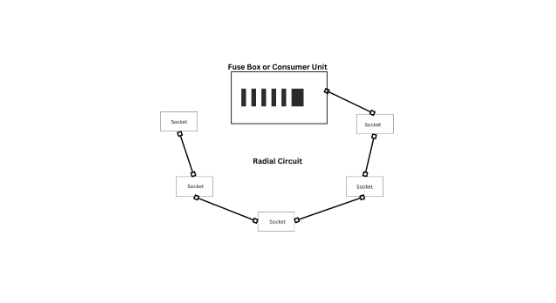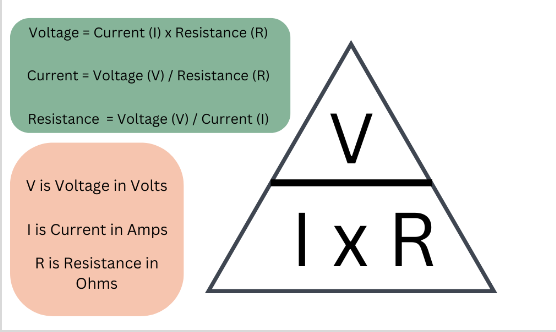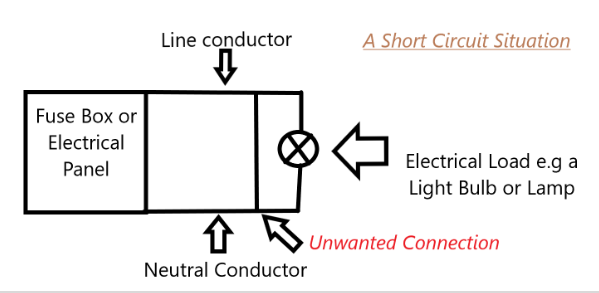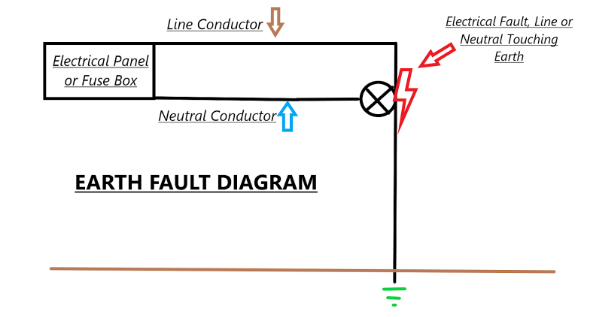What is an electric circuit, how does it work? - Electrical Faults Fixed
An electric circuit is a closed loop of wiring that allows electrons to flow from a power source, through components and devices, then back to the source. Think of it as a complete loop where electricity can travel, similar to water flowing through a circular pipe system. Without a complete loop the circuit is broken or "open circuit" and will not function.
In this article we will look at various electrical terminology, the construction of a circuit and how this applies in real life situations like our homes.
1) Typical Electric Circuit in Our Homes
In our homes we have the source of electricity which is usually the electrical panel or consumer unit. Then this is divided into electrical circuits, each protected by a circuit breaker or fuse. Then the cable goes out to each of the electrical accessories to power them. The most straightforward example is plug sockets.

There is a line conductor (sometimes known as live or hot) which carries the power supply to the plug sockets and a Neutral conductor which carries the electrical current back to the source completing the circuit. The electrical current flows through the line conductor of the appliance that is plugged in and back down the neutral to the socket.
Back to top2) Voltage, Current and Resistance
Let’s look at this in a way that's easy to understand. Think of an electrical circuit like a water pipework system.
Voltage is like water pressure – it's the force that pushes electrical charge through your circuit. We measure it in volts (V), and it's what makes everything flow. Without voltage, nothing happens. It's that simple. The higher the voltage, the larger the electrical force pushing charge around the circuit.
Current is the net rate of flow of electrical charge. Imagine water flowing through a pipe – that's basically what electrical current is, except its electrons moving through a wire. Current tells us how many electrons are flowing past a point each second, and we measure it in amperes (A) or amps for short. The stronger the current, the more electrical charge is flowing through your circuit. Think of current as the amount of water flowing per second.
Resistance is like a narrow section in our pipe – it fights against the flow. Every material has some resistance (except superconductors). When electrons bump into the atoms in a wire or component, they lose energy, usually as heat. We measure resistance in ohms (Ω). Various factors can affect resistance such as temperature, conductivity of the material that current flows through and cross-sectional area of wiring. (The larger our pipework, the more water can flow and the less resistance there is).
These three elements combine together in a relationship defined by:
Ohm's Law: Voltage equals current multiplied by resistance (V = I × R). It's one of the most fundamental relationships in electronics. Want more current? You'll need more voltage to push it through. Add resistance, and your current drops unless you crank up the voltage to compensate.

Think about your cell or mobile phone charger. It converts the high-voltage household current (around 120V or 240V) into a lower voltage that your phone can handle (about 5V). The resistance in your phone's charging circuit helps control the current so your phone charges safely instead of damaging the battery.
Back to top3) Power and energy in circuits
Power and energy are often mixed up.
Power is the rate at which energy is transferred - or how fast work gets done. In circuits, we measure power in watts (W), and it's found by multiplying voltage by current (P = V × I).
Think of it like water rushing through a turbine - more flow (current) and higher pressure (voltage) mean more power.
Energy is the total amount of work done over time. We measure it in watt-hours (Wh) or joules (J). If power tells us how fast energy is being used, energy tells us how much was used total.
Your electricity bill measures energy, not power - it's tracking how many watt-hours or kilowatt hours (Kwh) you've consumed over the month.
Here's a real-world example: A 2000W (2 Kilo Watt (Kw)) uses 2000 watts of power constantly while it's on. If you run it for 2 hours, it consumes 4000 watt-hours (or 4 Kilowatt-hours) of energy.
Pretty straightforward, right?
Power isn't always constant. In AC circuits, power can fluctuate, and some devices draw different amounts of power depending on what they're doing - like your laptop using more power when gaming than when idle. A Hi-Fi Amplifier uses more power at full volume than when playing quietly.
Back to top4) Short Circuit
A short circuit occurs when an unintended connection is made between the line conductor and the neutral conductor.

A large electric current flows when a short circuit occurs. This can reach several hundred or even thousand amps of current which would cause serious damage if the overcurrent protective device did not operate to shut the circuit off.
Back to top5) Earth Fault or Ground Fault
An earth or ground fault occurs when there is an unintended connection between the either the Line conductor and Earth (ground) or between the Neutral Conductor and Earth (ground). Such a situation may occur if a nail is driven into a cable touching Line and Earth together or Neutral and Earth together. Earth faults can also occur when water enters electrical cabling and allows small amounts of electrical current to leak to earth using water as the path to bridge the conductors.

6) Conclusion
This is a straightforward article explaining the concepts of electrical circuits and how they work. There are many common electrical problems that can occur as a result of an electrical circuit malfunction or with electrical components in our homes and with an understanding of how electrical circuits work, finding faults can be easier.
Back to top
Read more articles
- Log in to post comments


